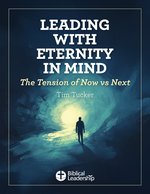2 things to build an unstoppable team
 iStock
iStock
A mentor of mine, a serial founder of businesses and non-profits, has a hat that sits on his bookcase. On the front is a list of all of the "titles" he carries. Most of them are informal— but real. It's tongue-in-cheek recognition of all of his roles or "hats" that he wears.
CEOs often wear many hats. Especially when they lead small or medium-sized organizations. There is a tendency to be the chief cook and bottle washer.
This often makes sense—and may even be necessary—as organizations start or experience rapid growth. But, if too many roles are retained for too long, it begins to inhibit growth.
That being said, there are two roles that all CEOs need to provide. Both roles are critical throughout the life of a business, regardless of the size or level of success achieved.
Common mistakes or misunderstandings about core roles
What does it mean to "lead" an organization? Financial growth is nearly always equated with growth. This is even true in the non-profit world where there can be great reluctance to discuss finances.
Chairing meetings, ensuring that goals are accomplished, maintaining some level of order or consistency, being the person with whom the buck stops.
These are all important roles. Without any of these, organizations struggle.
But while all of the roles are important, to a large degree, most of them can be delegated out.
Two can't.
Two core roles that all CEOs need to provide
The two roles that any CEO who wants to oversee a healthy and growing organization needs to embrace are that of being the Vision Bearerand the Cultural Architect.
There are two aspects of these roles that are important to understand.
- They are "soft" roles: They aren't technical skills. The results they produce are tangible, but the work required to produce those results may not seem tangible.
- They are internally generated: No one is forcing you to do this. There are no fires to put out. There is nothing to respond to. These roles are entirely fueled by something within a leader.
They are vision bearers
One of the most important practices of a leader is the ability to inspire a shared vision[i]. Of all of the practices a leader needs to engage in, this is the one that most sets a person apart as a leader.
You only need leadership if you are going somewhere (organizations that are staying and maintaining only need good management). Leaders can only lead to what they see. That's vision.
A leader's ability to formulate an inspiring and shared vision provides focus and fuels motivation.
A sharply defined vision creates a shared focus and allows for alignment. It reduces conflict, improves efficiency, and makes it easier to manage.
A focused, aligned, and motivated team is hard to beat. It's also impossible to build without vision.
A sign of decline for an organization is a leader who isn't able to inspire or produce a compelling vision of the future.
There aren't exceptions to this.
Here's an important caveat: Leaders need not be the source of the vision. The vision might be sourced from owners or a board. It might be generated from the team.
But successful leaders bear the vision.They bear it forward. They bear it into the meetings they participate in. They bear it into all the various functions and departments and locations that might make up an organization.
They carry the light of that vision high. They ensure that the vision illuminates that path forward for everyone in the organization.
They are cultural architects
Culture is shorthand for saying, "the way we do things." Or, to get slightly more technical, it is the core beliefs that shape attitudes that inform decisions and behavior.
If you want consistency and quality in organizational decision-making and behavior, you need to be intentional about the work done in the areas of beliefs and attitudes—especially within senior leadership.
Culture is most often grown on accident. It tends to follow the personality and preferences of a founder or strong current leader. It tends to be heavily impacted by negative events or experiences. Which often means organizational cultures are formed and informed more by reactions to what we want to avoid as opposed to who we want to becomeor what we want to accomplish.
To be a cultural architect, a leader needs to cultivate a shared understanding or belief system within the organization. This includes defining:
- Purpose and meaning. Why does this organization exist?
- What is important and why?
- Desirable attitudes. What mindsets or approaches to decision-making, relationships, opportunities, and challenges are expected?
- Success behaviors. What behaviors will lead to success? What won't?
This requires intentionality and effort. And no one is making you do this.
But if you do this work, you have the opportunity to build something very special.
How are you doing?On a scale of 0 (worst) to 10 (best), score yourself on the degree to which you believe you:
- Inspire a shared vision amongst your team?
- Actively and intentionally create and reinforce your organization's culture?
[i]The Leadership Challengeby James Kouzes & Barry Posner
Christian Muntean is a seasoned expert in fostering business growth and profitability. With a Master's degree in Organizational Leadership and certifications as a Master Coach, Certified Exit Planning Advisor (CEPA), and International Mergers & Acquisitions Expert (IM&A), he guides entrepreneurial leaders through growth, succession planning, and exit strategies. He is an accomplished author of three books, including Train to Lead. Christian resides in Anchorage, Alaska, with his family. Learn More » |
More on Vision & Culture
- Open borders or compassionate order? (by Bob Russell)
- They tried to quiet Charlie Kirk—but the gospel still speaks (by Bob Russell)
- What can Christian leaders learn from a 20-something YouTuber? Quite a lot… (by Zac McGowen)
- Steps to Launching Your Personal Workplace Ministry (by )


